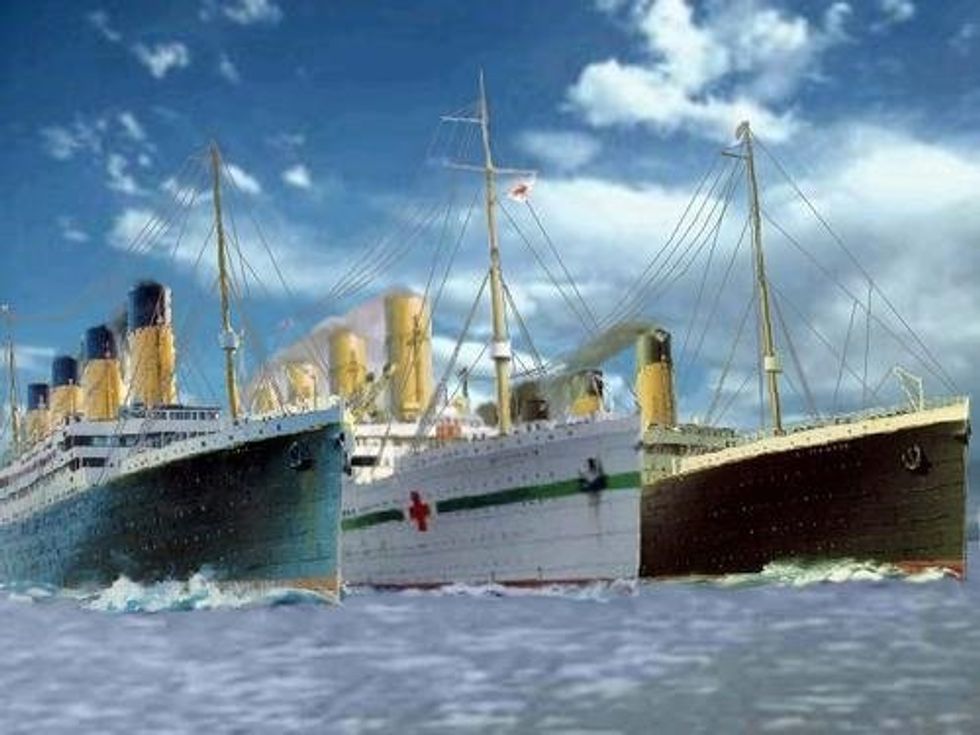Most people already know about the tragedy of the R.M.S. (Royal Mail Ship) Titanic – the fateful ship that struck an iceberg in the Atlantic Ocean and sank on April 15, 1912. What many don’t know, however, is that the Titanic had two sister ships. In fact, Titanic wasn’t even the first of her sisters built.
The R.M.S. Olympic was first launched in October of 1910, and she was declared ready for duty in May of 1911. Her maiden voyage, for the most part, went very well, and the people of New York were met with a ship the likes of which they had never seen. No one had ever built a ship that large before. Unfortunately, that is the main cause of Olympic’s many problems.
The first incident took place on her maiden voyage, right after she arrived in New York City. The other ships in the harbor were not prepared for the sheer size of Olympic, and a tugboat, the OL Hallenbach was pulled in by her massive propeller. The Olympic was unharmed (other than some scratches), but the Hallenbach was severely damaged by the encounter.
A second and more well-known incident occurred on September 20, 1911. The Olympic and the Royal Navy cruiser, HMS Hawke, were sailing too close to each other when the captain of the Olympic ordered that the ship be turned. The two ships collided, causing massive damage to both vessels, but, fortunately, they both managed to stay afloat. The Hawke’s bow was crushed, and Olympic suffered two large gashes ripped into her starboard side—one above the waterline and one below.
Ironically, the Olympic’s captain during both of these incidents was none other than Edward J. Smith – the man who would later go on to captain the Titanic on her maiden voyage.
The Olympic suffered many more unfortunate incidents (including cutting a lightship in half) in its long career. Despite this, the R.M.S. Olympic was the only one of White Star Line’s Olympic-class ships to survive to be decommissioned – even after serving as a troop transport ship in World War I. In 1937, Olympic was stripped, and her fixtures and fittings were auctioned off.
After the Titanic disaster, construction on R.M.S. Britannic (supposedly, it was originally meant to be called Gigantic) was halted until a full investigation could be completed. Eventually, construction began again, but several new safety features were added to the design (including, but not limited to, the proper number of lifeboats).
Britannic ultimately never became a passenger liner. By the time her sea trials had ended, WWI had broken out, and she was converted into a hospital ship and renamed H.M.H.S. (His Majesty’s Hospital Ship) Britannic. She was charged by the International Red Cross with the evacuation of wounded soldiers – most notably from the Isle of Lemnos and the Gallipoli campaign.
On November 21, 1916, Britannic ran into an underwater mine in the Aegean Sea’s Kea Channel—though, at the time, it was unclear whether it was a mine or a torpedo from an enemy submarine. There was a huge explosion, and the ship sank in less than an hour. This was partially due to a failure in the emergency bulkheads (incidentally, this was also one of the reasons for the Titanic’s sinking) and partially due to the portholes in the lower decks being left open.
Surprisingly, there were few casualties. The starboard lifeboats were quickly ordered to be lowered first—as the ship was listing to that side. Unfortunately, two lifeboats were launched prematurely (and without permission) and were sucked into the still-turning propellers. Thirty people were killed.
H.M.H.S. Britannic currently lies on its side in fairly shallow water. Her location was lost for many years, but she was rediscovered by Jacque Cousteau in 1975. It’s unfortunate that Britannic is not as famous as her younger sister, Titanic, as the Britannic’s wreck is far more accessible than her predecessor’s.





















